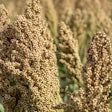
As genome editing technology expands, so do the opportunities to fight hunger and malnutrition globally. With the development of CRISPR-based gene editing, creating seeds which produce hardy crops with higher nutritional values and yields has never been a more plausible process for providing underserved populations with access to safe, fresh food — especially amid rampant global population growth and climate change.
CRISPR-modified crops to aid starvation and nutrient deficiency
One example of a genetically modified crop that has been doing its part to feed the hungry while also providing necessary nutrients is golden rice, a genetically modified crop that contains beta-carotene, a compound that nourishes the body with vitamin A. Vitamin A is not naturally created in the body and must be absorbed through food. Many African regions suffer from vitamin A deficiency (VAD), which can result in blindness, diarrhea and other illnesses.
Golden rice was approved by food safety regulators in Australia, Canada and the U.S. and was approved to be cultivated in the Philippines in 2021. Golden rice must undergo three to four cropping seasons before it can produce the necessary number of seeds for commercial farming, at which point more countries may begin growing it.
This is just one example of how CRISPR-modified seeds are not only doing their part to ensure continued success for the ag industry, but also providing biofortified foods to millions. Golden rice may solve the VAD crisis in Africa and Southeast Asia, which causes 250,000 to 500,000 children to go blind per year, with roughly half of them dying within 12 months of losing their sight.
BASF seeks to address future growth challenges
Chemical company BASF is attempting to support the future fresh food supply through genome editing. Using CRISPR-Cas9, a collection of editing techniques that introduce intended DNA alterations to the genome of an organism, BASF seeks to make it easier for farmers to grow more food with fewer resources.
“With precision genome editing techniques, like CRISPR-Cas9, breeders can deliver farmers more resilient, better adapted varieties in a shorter time frame than with conventional breeding techniques," the company said in a press release. "This enables growers to address challenges faster and proactively as they emerge on the farm.”
The aim is to create seeds capable of resisting the changes induced by a more unpredictable climate and progressively more chemical-resistant pests. While BASF doesn’t yet have any seeds on the market, their team has been working with CRISPR-Cas9 and other gene editing technologies to help protect the future of agriculture.
According to BASF senior vice president of research and development crop protection Jürgen Huff: “Much of the excitement around gene editing is its prospective use for disease therapy, but undoubtably, when this same technology is applied to agriculture, it can help us meet global food demands sustainably – if we let it.”
The seeds developed by companies like BASF may provide ag solutions for climate change, pests and a rising global population, as well as alleviate starvation in regions already suffering from all of these detriments.
Corteva Agriscience's CRISPR-fortified crop solutions
Another crop seed being developed with CRISPR technology is a type of corn that may be resistant to maize lethal necrosis (MLN) in sub-Saharan Africa. Corteva Agriscience, an agricultural chemical and seed company, is working on developing a hardier corn crop with CRISPR technology, in addition to soybeans, sorghum and canola. They’re researching with other companies and nonprofits under the umbrella of Seed Production Technology for Africa (SPTA). These fortified crops could mean a more reliable supply of fresh food for underserved populations.
Corteva's work with the MLN-resistant corn has been particularly fruitful so far. It is running field trials in Naivasha, Kenya, and once the expected results are reached, seeds will be disbursed to Kenyan seed companies for local farmers and food-insecure communities to benefit from. A field trial that is being conducted in Naivasha, Kenya.Courtesy Corteva Agriscience
A field trial that is being conducted in Naivasha, Kenya.Courtesy Corteva Agriscience
"Corteva Agriscience is leveraging our technologies and scientists to bring sustainable innovations to smallholder farmers globally who are facing some of the greatest pest, disease and climate challenges," Corteva said in a press release. "To solve some of the most pressing issues impacting smallholder farmer crop yields, these collaborations target critical crops which provide vital nutrition to the most food-insecure regions of the world."
Corteva is approaching the food crisis in select areas of the world with more than just MLN-resistant corn. They're also working on editing the genetic structure of pearl millet, a vital crop for "women smallholder farmers in sub-Saharan African and India," according to a press release.
Corteva Agriscience "seeks to reduce the rancidity in pearl millet that develops rapidly after milling. The ultimate goal is to extend the shelf life from days to months," a Corteva spokesperson said.
Millet is important to many Indigenous cultures in Africa and India, and it's also a crop that grows well in poor soil, can go without water for long periods of time, and requires very little fertilizer. Millet can be used to make various cereals and baked goods and, by extending its shelf life, Corteva may drastically change the food situation in these regions with science.
The spokesperson added: "We’re also working with researchers at Kenyatta University to develop sorghum lines that are resistant to infection by the parasitic weed, Striga. By measurably reducing Striga infection, farmers will see productivity increases and be better equipped to meet the food consumption needs of millions of people in this arid region."
CRISPR technology is one of many factors changing agriculture for the better and, with a few years more of research and development, the world could be a little less hungry.


















